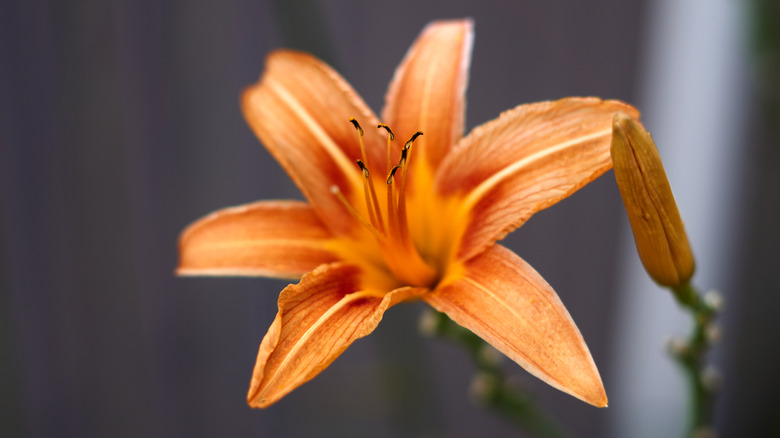What Are Ditch Lilies, And Why Are They So Controversial?
You've surely seen them — tall graceful stems with colorful orange petals streaked with yellow and red. Orange daylilies are common wildflowers that are very hardy and spread rapidly. But, as beloved as these flowers are to some people, there can be some issues with trying to grow them in a garden space. Many gardeners consider them invasive and problematic, — and, like any commonly-grown but invasive plants, there is a bit of controversy around them.
Orange daylilies (Hemerocallis fulva) are also known as ditch lilies, corn lilies, fourth of July lilies, tawny daylilies, or sometimes called tiger lilies (though these are more accurately Lilium lancifolium or Lilium tigrinum). These lilies are common not only because they grow and spread so assertively, but because people also find them beautiful. While this plant is commonly seen in both gardens and in the wilderness, they tend to spread widely and it can be difficult to eradicate once they have taken hold.
Why are ditch lilies so invasive?
The reason ditch lilies are so invasive is that they can spread both by spreading rhizomes, and by long trailing roots spreading from their clumps. Species daylilies only spread out from their central rhizome clumps. These flowers not only spread rapidly in your garden, but in the wild, they can crowd out and displace native perennials, and they're not particularly attractive to pollinators.
These plants aren't without their benefits, though. The clumps crowd out other weeds, and because they can grow in almost any kind of poor conditions, including rocky or clay soil, their roots can help prevent erosion on slopes. They can tolerate drought or abundant water, and even though they don't form flowers or bloom without sun, the clumps of leaves can grow and continue to spread even in full shade. Another problematic aspect of ditch lilies is that, because they're so tolerant of poor soil, they can form hard clumps in clay soil that make it hard to dig or divide them. Finally, like other lilies, ditch lilies are also toxic to cats.
How can I stop ditch lilies from becoming invasive?
There's no way to prevent ditch lilies from being invasive other than dividing and removing them on a frequent basis, to prevent them from spreading. It's not recommended to plant them in a garden setting because they will quickly become a problem. However, some gardeners will give them their own space, like alongside a driveway or fence, so they don't crowd any other plants.
If you do want to keep them, give them some good soil amendments to keep the soil loose and well-draining. This will make it easier to divide them in the future. Keeping them well-watered to try and soften the soil may make it easier to dig them up. The spreading roots are a bright yellow color and easy to identify, but if you don't remove all of the roots, they will come back again. Dispose of the plants away from your compost heap, so the roots don't spread into your compost.


